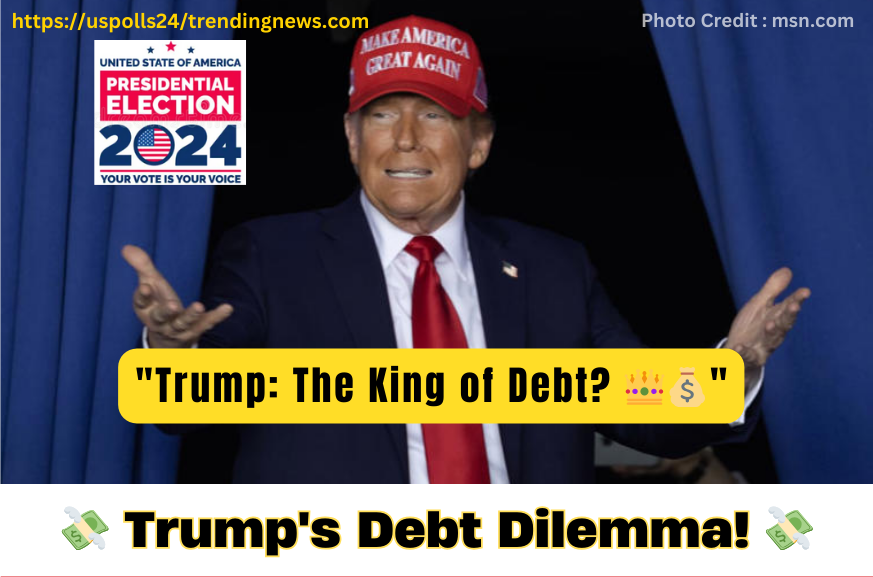“U.S. debt growth” Will be a myth or will it come true?
According to a recent report from the Committee for Responsible Federal Budget (CRFB), Trump’s reckless policies will lead to an increase in U.S. debt by a staggering $7.5 trillion over the next decade.
In the world of politics, promises are often accompanied by grandiose claims and extravagant rhetoric.
One of the most audacious claims comes from former President Donald Trump, who has styled himself as the “king of debt.”
His proposals for the economy are set to reshape the fiscal landscape of the United States significantly.
According to a recent report from the Committee for Responsible Federal Budget (CRFB), Trump’s reckless policies will lead to an increase in U.S. debt by a staggering $7.5 trillion over the next decade.
In contrast, Vice President Kamala Harris’ economic plan is projected to add $3.5 trillion—a figure that still raises concerns about fiscal responsibility.
Understanding the Debt Dynamics
The CRFB’s Findings
The CRFB’s report highlights the potential implications of both candidates’ economic strategies, noting that both plans could exacerbate the nation’s already precarious fiscal situation.
They project that without any changes from Congress, the U.S. is on track to face approximately $22 trillion in budget deficits over the next ten years.
Publicly held debt has already surpassed $35 trillion, and the added burden from these candidates could only worsen the financial outlook.
The Scope of Trump’s Debt Increase
An Increase in U.S. Debt
Trump’s proposals stand out for their sheer scale. The CRFB estimates that Trump’s economic policies could potentially increase U.S. debt by anywhere from $1.5 trillion to a staggering $15.2 trillion, depending on how certain economic factors unfold.
This wide range reflects the lack of specificity in Trump’s campaign proposals, leaving a significant degree of uncertainty regarding their actual impact.
A Closer Look at Trump’s Economic Policies
Tax Cuts and Their Consequences
Trump’s economic strategy is heavily centered around tax cuts. He has promised to extend the 2017 Tax Cuts and Jobs Act (TCJA), a move that is expected to cost an astronomical $5.4 trillion.
In addition, he has proposed ending taxes on tips, overtime pay, and Social Security, which adds to the financial burden of his plan.
His relentless focus on tax reductions raises questions about how the government would manage to sustain essential services and programs in the face of declining revenue.
Tariffs and Drilling: The Revenue Debate
To offset the cost of his ambitious plan, Trump touts two primary sources of revenue: tariffs on imports and expanded oil drilling on protected lands. These strategies are expected to generate $3.7 trillion over a decade.
However, the CRFB estimates that Harris’ proposal to raise taxes on corporations and high earners would yield even more—around $4.3 trillion—making her plan appear more financially sound in comparison.
Comparing Harris’ Approach
A Focus on Equity
While both candidates present plans that contribute to the U.S. debt, Harris’ approach seems more cautious.
She proposes to extend TCJA benefits to Americans earning less than $400,000, with a projected cost of $3 trillion.
This stance highlights a fundamental difference between the candidates: Harris appears to prioritize equity and long-term fiscal health over Trump’s more extravagant promises.
The Uncertain Economic Landscape
Despite the differences, both candidates face criticism for failing to provide specific details about their plans.
The CRFB notes that the uncertainty surrounding these proposals complicates any definitive analysis of their economic implications.
While Harris’ plan is projected to add $0 to $8.1 trillion to the debt, the uncertainty surrounding Trump’s policies remains more pronounced.
The Bigger Picture: Implications for the Future
The Challenge Ahead
The increasing debt burden poses significant challenges for future generations.
The debate over how best to manage the U.S. economy is critical, and it’s essential to scrutinize the promises made by those seeking the highest office.
Trump’s reckless policies will lead to an increase in U.S. debt, creating an uphill battle for economic stability.
Fiscal Responsibility in Focus
In the end, both candidates must address the dire need for fiscal responsibility in their plans. With the national debt at a historic high, the implications of their proposals will be felt for years to come.
It’s crucial for voters to consider not just the immediate benefits of tax cuts and spending promises but also the long-term consequences of increasing debt.
Conclusion: The Path Forward
As the election approaches, the choices made by voters will ultimately shape the nation’s economic future.
Trump’s reckless policies will lead to an increase in U.S. debt, while Harris’ more tempered approach offers a different vision for America’s fiscal health.
The decisions made in the coming years will reverberate long after the election, making it essential for voters to engage critically with the candidates’ economic plans.
Examining Harris’ Tax Policies
Will Harris Raise the Corporate Tax?
A key question emerging from the electoral discourse is, “Will Harris raise the corporate tax?” Her proposals suggest a focus on increasing taxes for corporations and high-income earners to help fund essential services and reduce the national debt.
By targeting wealthier entities, Harris aims to create a fairer tax system that alleviates some of the financial burdens on the middle class, in stark contrast to Trump’s promises of sweeping tax cuts.
This approach not only addresses immediate budgetary needs but also raises important considerations about long-term economic equity.
The Impact on Voter Sentiment
As polls indicate Harris leading Trump, voters may be increasingly supportive of her stance on corporate taxation.
Many Americans are looking for solutions that prioritize fiscal responsibility and social equity, making the question of corporate tax raises a pivotal issue in the upcoming election.


1 thought on “Trump’s Reckless Policies Will Lead to an Increase in U.S. Debt”